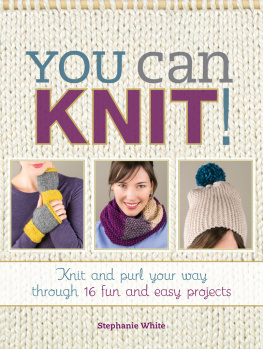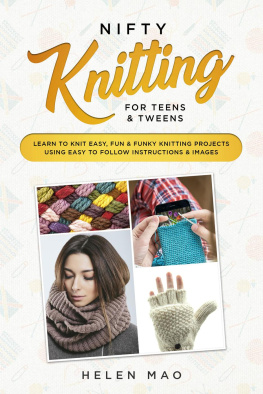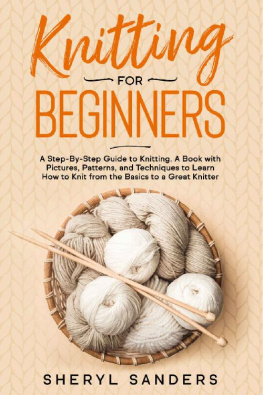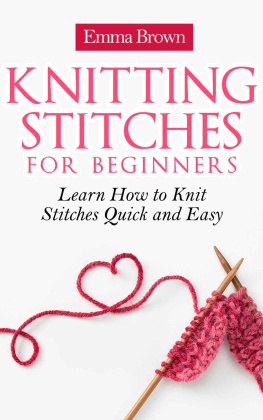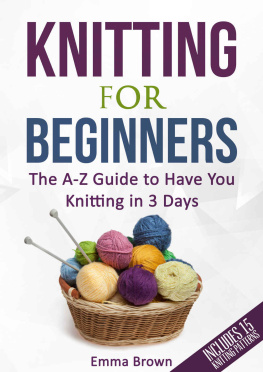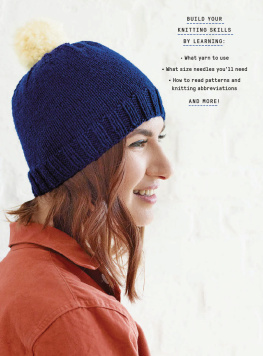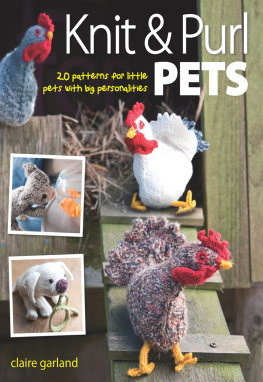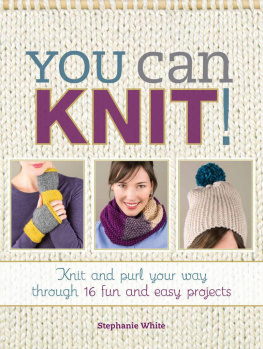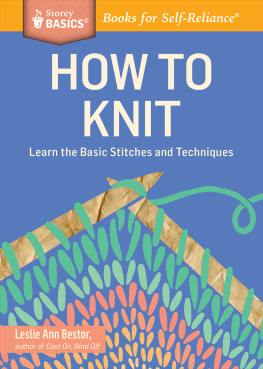Thank you for purchasing this Martha Pullen eBook.
Sign up for our newsletter and receive special offers, access to free content, and information on the latest new releases and must-have crafting resources! Plus, receive a coupon code to use on your first purchase from Store.MarthaPullen.com for signing up.
or visit us online to sign up at
http://marthapullen.com/ebook-promo
This book is dedicated to the knitting fairy (aka my mom).
Contents
Introduction
Look, Im not going to waste your time telling you how easy knitting is and that its something blindfolded babies can do. Of course I think its easy; Ive been knitting for the last twenty years. The important thing to take away from this introduction is that you can knit. I really mean that. Some people may take longer than others to get the hang of it, but at the end of the day, it is a skill you can master. Or, if not master, at least do passably well.
In writing this book, my goal was to make you feel like Im sitting right beside you every step of the way. Unlike other beginning knitting books, Im not just going to show you the basics and cut you lose; I will show you the basics, then show you exactly how those basics make the projects in this book. Yes, you may still run into trouble. At that point, you should flip to the Common Mistakes section at the end of the book. But really, at this stage in the knitting game, the best way to fix a mistake is to rip it out and start over. Once youve done that once or twice, youll realize that making mistakes isnt so scary, because youve already experienced the worst that can happen (starting over) and come through it a better knitter.
Theres a little bit of info you need to know before you get started, so scan the next few pages, then turn to Chapter One and learn how to knit. Youve got this.
What is Knitting?
At its most fundamental, knitting is just a series of interconnected loops. Each time you knit a stitch, youre pulling a new loop through an existing loop. In the knitting world, we dont refer to them as loops. We call them stitches, but they really are just loops.
There are two types of stitches you can make: a knit stitch and a purl stitch. Both of these stitches are just loops. The only difference is how you pull the loop through the stitch below. This will make a lot more sense once you actually start knitting.
All of the projects in this book are combinations of knit and purl stitches. When you learn a new stitch pattern (confusingly also referred to as a stitch), youre just learning a new way to combine knit and purl stitches. To make the garter stitch, you only need to know the knit stitch. Stockinette stitch is also just a stitch pattern that uses knits and purls. Again, all of this will become clear as you start working on your projects.
Another confusing bit worth mentioning is the term knit.f People use it to refer to both the specific knit stitch and the activity itself, encompassing all the various stitches, stitch patterns, etc. When writing the instructions for this book, I tried to use the word knit only when you actively need to knit a stitch, not purl a stitch, nor when you work a pattern stitch. Hopefully this will help lessen any confusion.
How to Use This Book
This book assumes youve never knit before, or if you have, you really dont remember how you did it. There are four chapters, with each chapter building on the previous chapter. Within each chapter are three coordinating projects, all using the same needle size, type of yarn and stitch pattern.
Each chapter begins with a gauge swatch tutorial. Knitting a gauge swatch is a step that many knitters skip, but it really makes a difference to your finished projects. Every pattern calls for a specific gauge: So many stitches over so many rows equals a certain measurement. Your knitting needs to come out to that same measurement in order for your finished project to be the right size.
Full disclosure: Getting your gauge exactly right isnt crucial for the projects in this book. In fact, dont worry about the row gauge at all. The patterns almost always tell you to knit to a certain length, so if it takes you more or fewer rows of knitting to get there, its no big deal. As for making sure you have the right number of stitches per inch (2.5cm), as long as youre close, it should be okay. These projects are forgiving, so if youre off slightly, dont worry about it.
That being said, its still important to knit the swatches. Each swatch in this book serves as a practice project, introducing you to the techniques youll need to finish the other projects in the chapter. When youre done with the swatch, youll turn it into a mug mat or coaster. That way its practice you can use.
If youre slightly more familiar with knitting, you can skip through the step-by-step photos and head straight to the end of each project. There youll find the straightforward, no-frills knitting pattern. Beginning knitters should look at the patterns from time to time, too. Its helpful to see how all the work youre doing translates into a pattern.

Another fun bonus: Each project calls for yarn individually. However, at the beginning of each chapter, you can see how much yarn youll need if you want to knit all of the projects in a chapter (usually a lot less than if you just add up the yarn called for in each individual project). Knit all the projects. Make yourself coordinated accessories. You wont regret it.
And there you have it. Start with the first chapter, knit up your gauge swatch, then dive into the projects. If you want to skip around a bit, thats fine. You can always flip back to an earlier chapters gauge swatch to brush up on a few techniques if you need to.
Tools + Materials
CHOOSING YARN
Choosing yarn was my favorite part of writing this book. There are so many colors, textures and materials to choose from. Sometimes this can be a bit overwhelming, and for that reason, Ive told you exactly which yarns Ive used for each project, in case you want a no-brainer option.
If youre choosing your own yarns, the first thing you need to be aware of is the weight of your yarn. The projects in this book use three different weights: super bulky, bulky and medium weight. Super bulky is the heaviest of the three; its great for knitting projects fast. Bulky yarn is slightly less thick and dense, but is still great for quick knitting. Medium is the thinnest of the three, but its a very popular weight, so youll have tons of options when youre looking for yarn. There are other weights, smaller than these three, but we wont use them in this book.
To determine what weight a yarn is, look at the label. Youll find a picture of a skein (or ball) of yarn with a number on it: 4 is medium, 5 is bulky and 6 is super bulky. When choosing yarn for these projects, make sure you choose a yarn that is the same weight as the original project.

